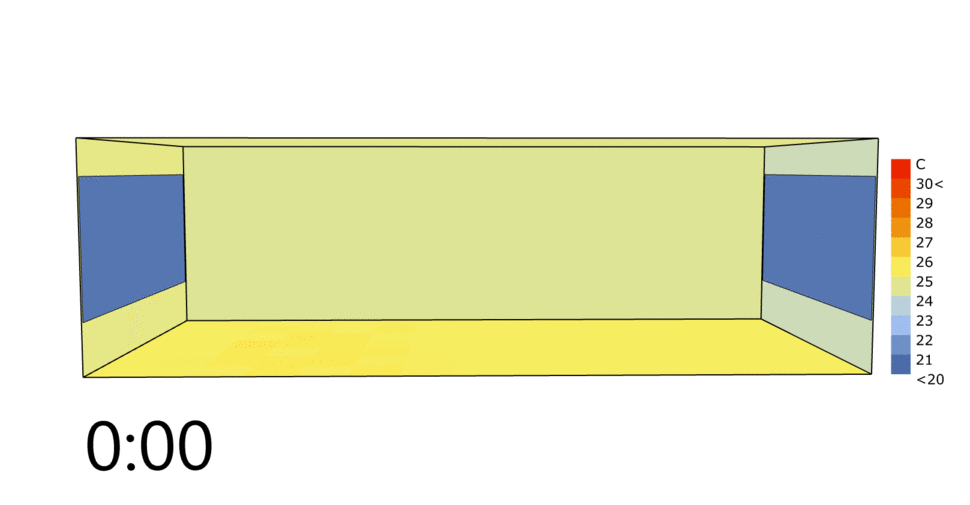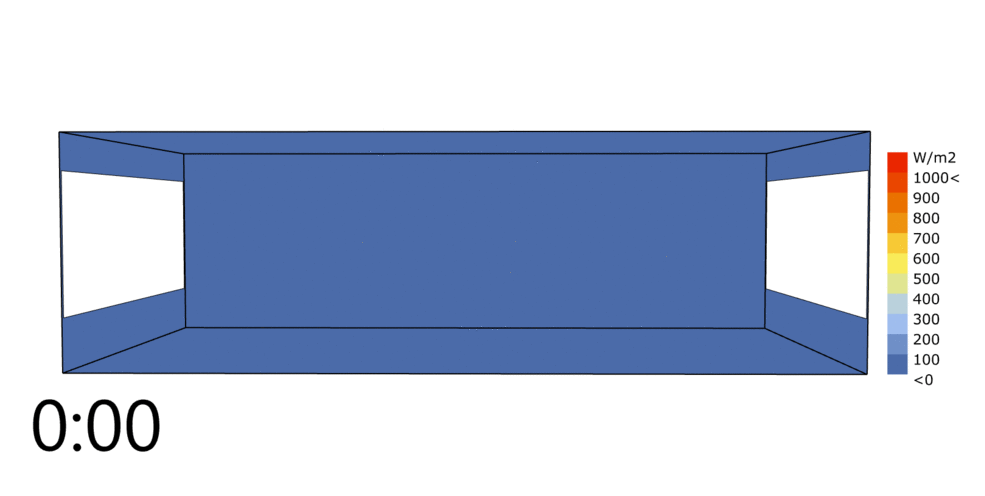Splotchy-ness of EnergyPlus Shadow/Solar Distribution Calculations?
Hello All,
I am trying to use EnergyPlus to understand surface temperature variations across a single room over the course of a day. To do this, I have subdivided a zone's surfaces into many smaller ones so that there is a grid of surfaces and I can get individual surface temperatures for each small surface. I increased the Solar Distribution model up to FullInteriorAndExteriorWithReflections, I set the Shadow Calculation to use timestep frequency and I increased the timestep to 12. I have colored the surfaces with their interior temperature and created this animation that shows the variation over the course of the day:

Generally speaking, the results are as I expect, with the west wall increasing in temperature in a pattern similar to how low angle sun would come through the south window in the morning. However, you will see that the pattern of surface temperature on the floor is not perfectly as I would expect since it is a bit "splotchy". I double-checked to be sure that the normals of all the floor surfaces are facing the right direction and I also tried changing the weather file but I ended up with the exact same type of pattern on the floor. So I am pretty positive that it is not the result of the geometry or the weather file. What makes me think that it is a simulation parameter (like the number of rays used in the solar distribution or shadow calculation) is that I have experienced very similar types of splotchy-ness when I run Radiance simulations without high enough Radiance parameters.
So my question is whether anyone knows if the splotchy-ness that I experience here is the result of a fundamental limitation of EnergyPlus's shadow calculations or is there a setting somewhere that could increase the number of rays used for such calculations?
Thank you all!
UPDATE
In response to some questions raised here, I wanted to confirm that the surface temperatures in the previous GIF that I posted are the direct result of the solar calculation. You can see the surfaces colored with the Surface Inside Face Solar Radiation Heat Gain Rate per Area in this GIF:

I also wanted to clarify that I have changed the Maximum Figures in Shadow Overlap Calculations to be very high without any noticeable change in the simulation results or the pattern in which sun falls on the floor surfaces.
Lastly, I also wanted to acknowledge that one solution to the issue here was posted in a previous answer to a question that I had posted here on this forum. Specifically, one could use the SurfaceProperty:SolarIncidentInside object to override the EnergyPlus solar calculation with a result from Radiance. However, this is not as elegant or time efficient if there is a way to boost up the parameters of the EnergyPlus calculation. So, if anyone knows of a parameter to change that could give me a different result here, that would be very helpful.




This question (and gif) is 🔥 and I hope it gets answered. I'm curious if you see the same effect by plotting the surface radiant heat gain, rather than using temperature as a proxy. Also is the 'splotchyness' consistent for e.g. successive runs/slightly different orientations/window sizes?
@chriswmackey Is there a significant difference in the energy use of the building if you have many small surfaces on the floor versus a single surface? If so, you could report this as a bug in the energyplus github issues.
Does the ShadowCalculation object have any influence here? More specifically the Maximum Figures in Shadow Overlap Calculations
Thank you all for the comments. I added an UPDATE to the original post with answers to @Eric Ringold 's and @rafael.alonso 's questions. @mldichter, the zone energy use does not significantly change with more surfaces and the purpose of this model is not to assess energy use. I am modeling surface temperature variations to understand thermal comfort conditions across the space.